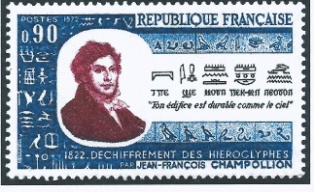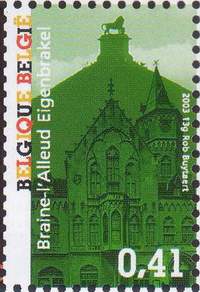Manifestations (préventes, bourses, etc...)
Exposition internationale et bureau temporaire Braphil '15
MORRIS Margaret Royal Philatelic Society London
Napoleon in Egypt
Introduction
Napoleon was a fearsome enemy but not everything he did was bad. In particular, when he embarked on his Egyptian campaign, in addition to a sizeable army he took with him a company of mathematicians and scholars. While in Egypt they carried out much useful work which has had a lasting impact on the history of Astronomy as on the understanding of this early culture.
 This exhibit attempts to demonstrate that astronomical events prior to and during Napoleon’s lifetime may perhaps have influenced this decision. It is likely that he would have heard about these events and discoveries, and understood their significance.
Please note that this has nothing to do with Astrology !
This exhibit attempts to demonstrate that astronomical events prior to and during Napoleon’s lifetime may perhaps have influenced this decision. It is likely that he would have heard about these events and discoveries, and understood their significance.
Please note that this has nothing to do with Astrology !
1. The state of European Astronomy during the Lifetime of Napoleon.
Napoleon was born in 1769 – by coincidence the year of a rare astronomical event known as Transit of Venus. These alignments occur in pair 8 years apart and separated by intervals of 105*5 and 121*5 years. Results from the 1761 transit had been too satisfactory and therefore special efforts were made to observe the 1769 event from various parts of the Earth. The aim was no less than to determine the scale of the Solar System. The British King George III provided funds and HM Bark “Endeavour” was sent to Tahiti under the command of Captain James Cook with the astronomer Charles Green on board. The young Napoleon, as a member of a good family, would have been the subject of discussion and he would likely have heard of it as a boy.
From 1779 he received a French education and surely Astronomy would have been discussed. Georges Louis Leclerc, Comte de Buffon (1707-1788), was translating scientific works into French, including those of Newton. In 1781, William Herschel discovered the planet Uranus – another outstanding event of this period.
The young Napoleon as a cadet in the army may well have come across the work of Jurij Vega, a professor at the Artillery School in Vienna. Vega’s mathematical ability enabled him to direct mortar fire accurately. This would have been of interest to Napoleon as an artillery officer. When he later joined the topographical service of the French army, he would be aware that telescopes were developing and were used by surveyors, explorers and, of course, the military. Astronomical methods were being used to measure the Earth. Charles de la Condamine measured a degree of the meridian near the equator while de Maupertuis went to Lapland to verify Newton’s hypothesis that the Earth is not perfectly spherical.
During the period of the Revolution, a new calendar was introduced and alternative methods of time-keeping were proposed. Baily was prominent not only for his contributions to astronomy but as a political leader. A few years later the first asteroid was discovered by Piazzi and named Ceres.
2. Egyptian Astronomy
The Egyptians were the first to calculate a reasonably accurate figure for the length of the year – very important for an agricultural people. Astronomer recognised the heliacal rising of the bright star Sirius which heralded the annual Nile inundation, bringing wealth and plenty. A year length of 365 days was recognised, later adapted to provide 12 months of 30 days plus a special 5-day period at the start of every year. Day and night were divided into twelve hours each. During the Old Kingdom, astronomers were involved in the accurate alignment of the pyramids. Early surveying methods ensured that a shaft in the Great Pyramid of Cheops pointed directly to the Pole Star of that epoch (Thuban). A water-clock was invented.
 3. “Only in the East can one do Great Things”
3. “Only in the East can one do Great Things”
On 1798 July 1 Napoleon landed in Egypt and, in addition to his army of some 54.000 men, he took a group of 150 scientists, engineers and scholars. The battle was lost but the cultural gains had lasting significance. The pyramids were carefully measured, and ancient Egypt was explored – for example, the temples and tombs of Luxor and the Valley of the Kings.
There was discovered in the temple at Denderah a magnificent carved ceiling with an elaborate representation of the Zodiac. Perhaps the most important discovery of all was the Rosetta Stone which enabled Champollion to break the code of the ancient Egyptian hieroglyphs.
4. A Modern Twist
Given the foregoing it is perhaps not too surprising that when ESA designed a spacecraft to investigate a comet, it was given the name “Rosetta”. Ten years and some 500 million kilometres later, Rosetta arrived at Comet 67P/Churyumov-Gerasimenko and a tiny probe was launched to land on the surface. This probe was named “Philae”, enhancing the Egyptian connection.
5. Conclusion
Finally, mention should be made of Manuel Johnson. He was born in 1805 and educated by the East India Company, training as a soldier. After various campaign, he ended up on St. Helena where part of his duties consisted in guarding the tomb of Napoleon. Johnson was a skilled observer and made use of his time on the island by producing a catalogue of 606 southern stars which earned him the Gold Medal of Royal Astronomical Society (founded in 1820).
It is perhaps more than a coincidence that Napoleon lived through such an exciting time in the history of Astronomy. We shall never know whether he was influenced by this, but it is an entertaining speculation.

